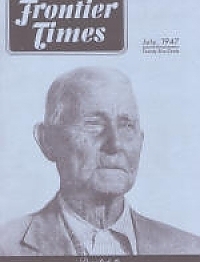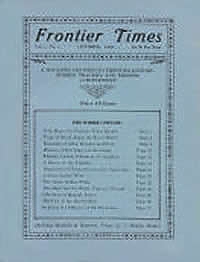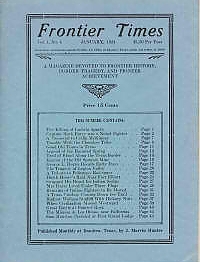By using our website, you agree to the use of cookies as described in our Cookie Policy
Magazines & Instant Downloads
Vol 24 No. 10 - July 1947
Callahan County Pioneer Passes Away
[Note: This is exceptional early genealogy and history of Callahan County, TX]
Account of J. S. Hart, born in Palo Pinto county, February 17, 1863 and was a beloved pioneer of Callahan county, TX. In this account, his life story is written just as it was told by Mr. Hart to his grandson, J. C. (Buddy) Hart, of Baird.
Mentions: his Baird home , Ross cemetery , family moved to Texas from Mississippi and settled on Bear Creek, south of Fort Worth , In 1868, the Hart's and Hitson's came to Callahan county, settling on the old John Trent place on the Bayou and the Hitsons on Battle Creek, northeast of Putnam , Jim Ned in Coleman county , John Heslep and Bill Starnes , J. E. Heslep , Jim Hart , Deep Creek, northeast of Baird , the Whittons , Jim Blair , the Bell ranch , Mack Wilson , Jesse James, a notorious outlaw , The Hitson's owned ranches at Greeley and Denver , Sebe Barnes , Sam Bass' gang , Cedar Creek. Ky , Eubanks , Caddo Creek , the Collins ranch , Jim Murphy , Daniel Dodds , The Hitson Creek , the present town of Moran , Old man Terry , old man Green , Mary's Creek , Al McLaury , Truede Purcell, G. M. Taylor and Charley Houston , Green Riddle , Old Dr. Thair , A. R. Kelton at Belle Plain , Mrs. Merchant , H. C. Hoard , Sis and Pete Henderson, George and Henry Steen, Mary Dodd and Dollie Lee, John, Frank and Fannie Morrison, Willie and Doug Hart , T. E. Hayden, Jr., of Abilene , Jim and Daniel Dodd , Mary Dodd , W. B. Dodd , the Newman land , Live Oak Creek , Tom Hazelwood , Gyp creek , the G. S. outfit , the Spur Cattle outfit , Ed Hayden, of Moran , Pete Scroggins and Boley Brown , the Sharp Music crew , Kent county , A .W. (Doc) McBride , Galbreath , Mrs. Kitrell , The Kitrells lived near Mount Pleasant , Paluska , Mary Dodd Smith , the G. S. Ranch , Callahan City , J. H. Tucker , Weatherford , C. L. Terry , T. L. Annie , Judge I. M. Onins , the town of Putnam , Gould City , Hall Cut , Matthew Baird , Pacific Railway Company , Dutch Tinker , Cat Claw , Brenom , Isreal Putnam , Uncle Dan Hadley , Mexia Creek , Some of the early settlers who came here were the Jacksbns, Hesleps, Dodds, Steens, Owens, Hendersons, Eubanks, and Warrens. , J. E. Heslep , Ella Heslep , Ella and Margaret Dodd , Harry Smith , Charlie Taylor , Mugginsville on Deep Creek , D. K. Taylor , Mr. S. E. Settle, the County Clerk , John Heslep , Brady Creek , B. L. Russell. Sr , Mrs. L. L. Blackburn , Eliza Gilliland , the McCoy Ranch on the Pecan Bayou , Hugh McDermitt. Fred Heyser of Putnam , T. T. Haney of Clyde , Fred Heyser , Mrs. Carroll McGowen , the Cross Plains Review , Jasper McCoy , Jack Scott , S. E. Settle, county clerk.
The Early Day Doctors
J. Marvin Hunter, Sr.
Back in the old days, when Texas was a young republic, there was not many doctors to treat the ills of the people, and most of the early settlers had to resort to homeopathic remedies in treating malarial fevers, intestinal diseases, respiratory diseases, typhoid fever, dysentery which was generally called "bloody flux," pneumonia, pleurisy, diphtheria, colds, whooping cough, measles, bilious colic, yellow jaundice, etc., and some of the remedies used in the treatment of those diseases effectively were indeed simple and ridiculous. This account describes pioneer medicine.
Mentions: Sion R. Bostick , Tom Williams , Kuykendall , Captain Burnam , Jesse Burnam , Tansy roots, catnip, camphor roots, Jerusalem oak, poke root , Epsom salts, castor oil, asefoedita, tincture of rhubarb, turpentine, calomel or blue mass, porous plasters, ginger, mutton tallow, sulphur, cherry pectoral, liniments.
Negroes At San Jacinto
Ed Kilmar
Account describes the role played by negroes in the battle of San Jacinto. Mentions: Prof. J. E. Gooden , Col. Leonard and Jared Groce , Groce's plantation , Hempstead , Lou Kemp and Houston Wade , Maxlin Smith , a Negro named Dick , Joseph Sovereign , Benjamin Fort Smith , Deaf Smith , Hendrick Arnold , Greenbury B. Logan , Capt. John York , James Richardson , Greenberry and Caroline , Big Creek , F. M. O. Fenn of Richmond , Greenberry Logan , William Goyens or Goens , William (Bill) Goyens , Goyens Hill , Joseph Tate , Capt. James Chessire , Joseph Tate , Thomas Stephens and Maxlin Smith , Capt. James Shessire , Peter Allen , Professor Gooden , Mrs. Paul Le Gros , Senator Claghorn , Parson Jack Potter.
Fighting Jack Potter
A Story of the "Fighting Parson" Andrew Jackson Potter commonly known as Fighting Jack Potter. This fearless Methodist Preacher traveled through Uvalde, Bandera, Kerr, Kendall, Mason, McCulloch, Menard, Tom Green and other counties in the late 1860s 1870s and 1880s. His name was a household word from the Panhandle to the Gulf; from the Colorado to the Rio Grande and the stories of his wit, prowess and adventures were sent abroad in the nation by press and pulpit. Born in Charito county, Missouri, April 3, 1830. He was the son of Joshua and Martha Potter, natives of Kentucky. In early years, wild, rebellious, routy and untamed, he eventually became a fierce Indian fighter, soldier, teamster, frontiersman, and preacher, whose fame and courageous reputation preceded him and whose respect was legendary.
Indian Depredations On Early Settlers
Judge John H. Chrisman settled in Coryell county, Texas, in 1854. He practiced law at Gatesville and served several years as chief justice of this county. He was slightly over 100 years old when he died. During the more than half century that he lived in Texas he had kept a record of the Indian depredations in and around Coryell county. These records are the substance of this article, and are herewith printed by permission of the Old Settlers' Association of Bell county.
Mentions: Charles Elam, a man about 36 years of age, lived on Henson Creek, ten miles southwest of Gatesville , Colonel H. W. Cook, who lived a few miles above Gatesville on the Mayberry place , Col. J. M. Norris, W. W. Hammack , William Lewis , Fort Gates , Brownwood , Lampasas , Mr. Lewis , his little boy Willie , Mullen's ranch , Neals Crook in Bosque County , Mrs. Wood and Miss Lemley , Miss Lemleys , the town of Stephenville , Two young men by the name of Monroe and one named Knight , Mr. White , A man named Johnson was murdered at Johnson's Peak , Captain R. B. Rarry , old man Perryman , Cow House Creek ,
Some Arizona Outlaws
Lorenzo D. Walters, who died at Tucson, Arizona, March 22, 1943, was one of the best informed men in that state on the activities of outlaws and renegades. He was a peace officer for many years, and came in direct contact with some of the most noted outlaws of the1890's. In 1925, Mr. Walters gave the editor of Frontier Times the following story about certain "bad men" of the old days.
Mentions: Cochise , The Wells Fargo Express Company , Dragoon Pass , Burt Alvord was constable at Willcox , Bill Downing , Perry Smith and Al Wien , Sheriff Scott White and George Scarborough , Constable Burt Grover of Pearce and Deputy Sheriff Page of Johnson , Matt Burts , Wells Fargo officer Billy King , the Bucket of Blood Saloon , Billy Stiles , Jailor George Braven , Bill Trainor , Bill Downing , Deputy Sheriff Billy Speed , Sam Bass , Sheriff Del Lewis , Casa Grande, Ariz , Tombstone , Bravo Juan , Tom Yoes , John Patterson, alias Jess Dunlap, alias Three-Fingered Jack, Bob Brown and the two Owens brothers , Jeff Milton , Bob Brown ,
The Southern Overland Mail In Texas
Col M. L. Crimmins
When California was acquired by the United States in 1849, one of the first problems to solve was how we could make contact with that distant possession. The voyage around the Horn was very long, slow and not without danger. The route via Panama was especially dangerous on account of yellow and other fevers. The Overland Route had its peculiar difficulties, although much shorter and equally dangerous.
The Southern route for a railroad had been surveyed through Texas by Captain John Pope and Captain Randolph Marcy, U. S. A. On March 3, 1857, Congress approved an act authorizing bids for a semi-weekly mail service from some point on the Mississippi to San Francisco, California. On July 2, 1857, the contract was awarded John Butterfield and others. The Southern route was selected as it was passable all seasons. The route entered Texas at Colbert's Ferry, near Preston on the Red River, and passed in a west-southwestern direction of El Paso, a distance of 740 miles and the time schedule was eight days and nights. Butterfield was to receive $600,000 a year for four years for the service. The total distance of the route from Tipton, Missouri, to San Francisco, California, was 2795 miles, to be made in 25 days. Here is the story.
Mentions: Comanche Springs , Girvin , Horse Head Crossing on the Pecos , Fort Belknap , Graham, The coaches were made in Concord, N. H., by Abbot-Downing , Dragoon Springs, Arizona , Indian Wells on the Yuma , Hueco Tanks , General Pershing's Punitive Expedition, from Columbus, N. M. in March 1916.
$4.95
‹ Back








